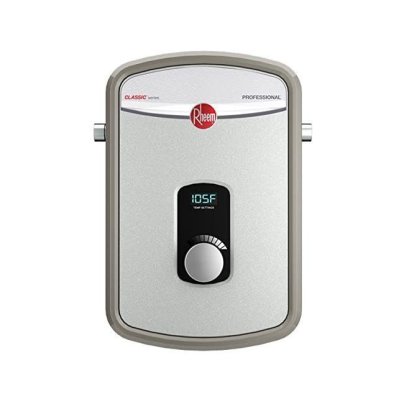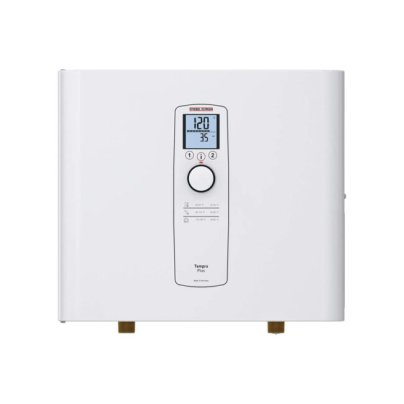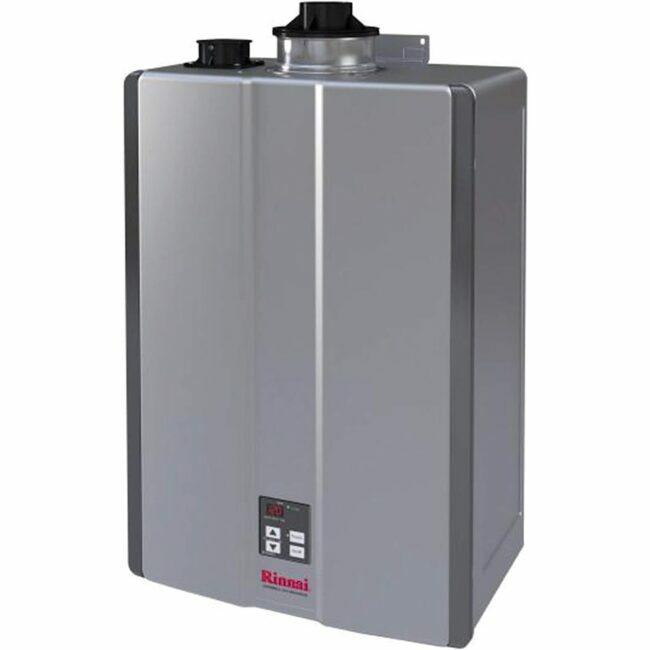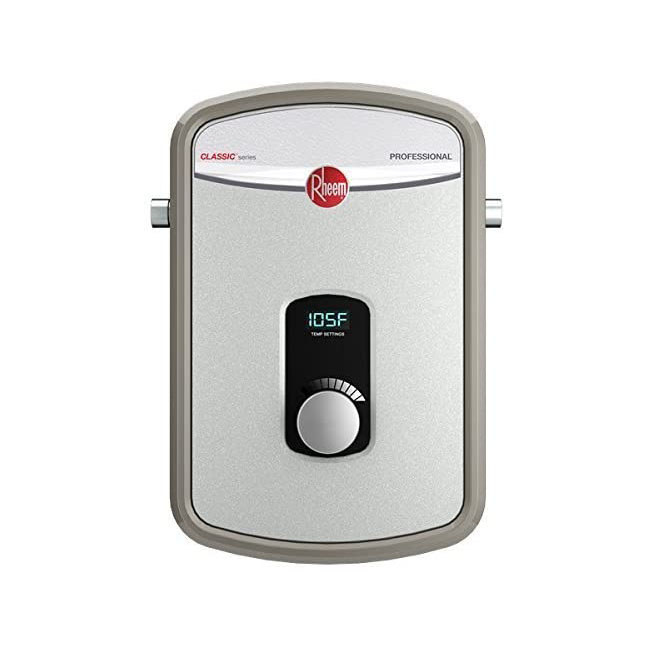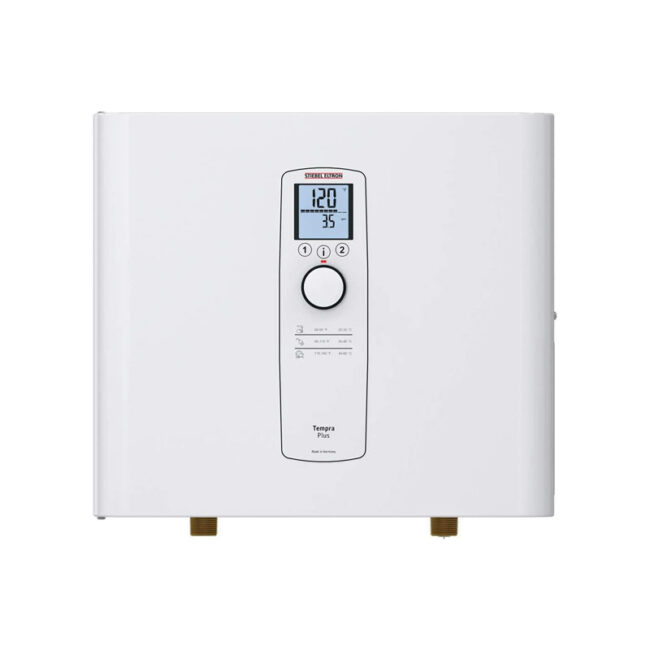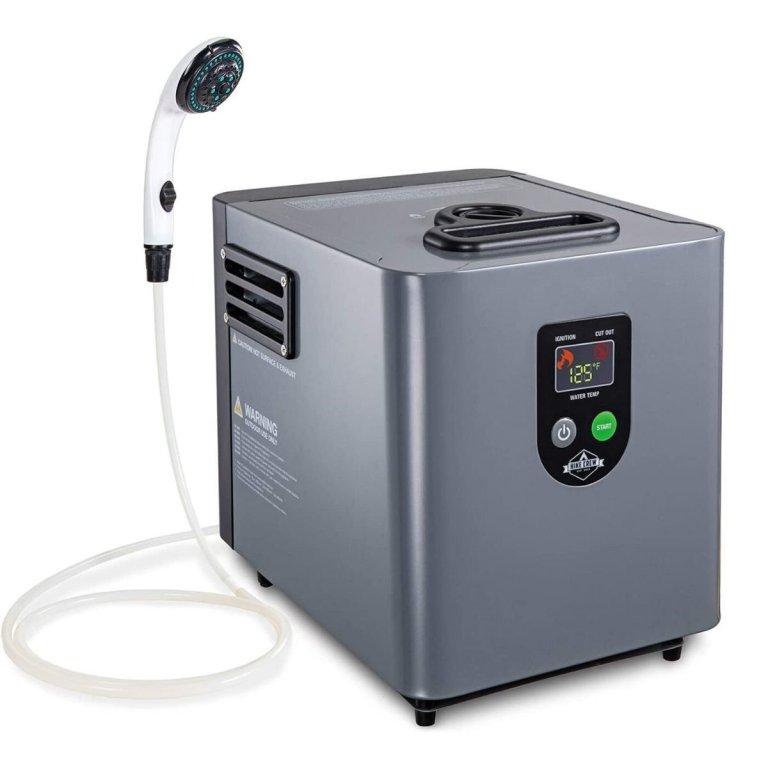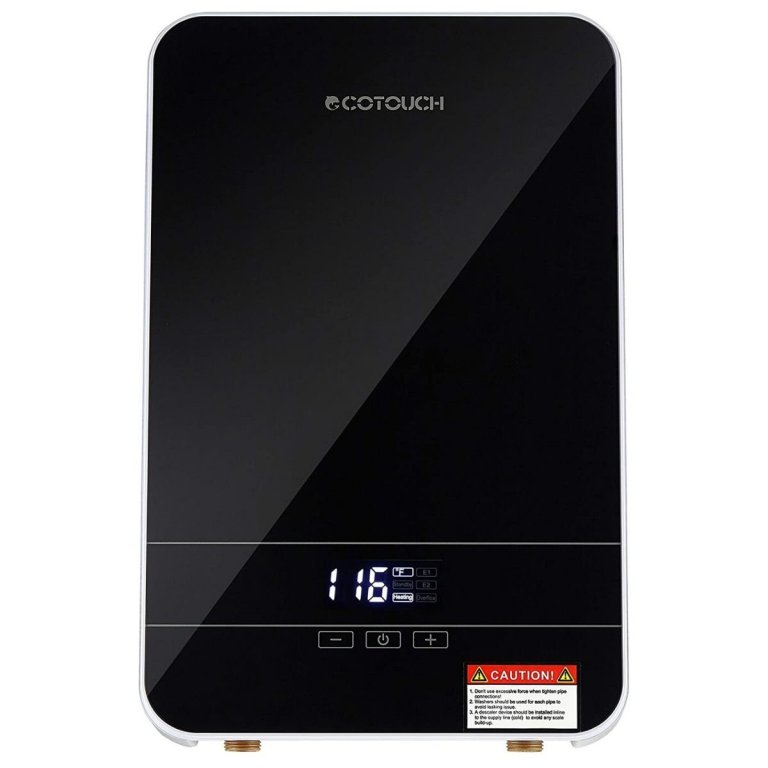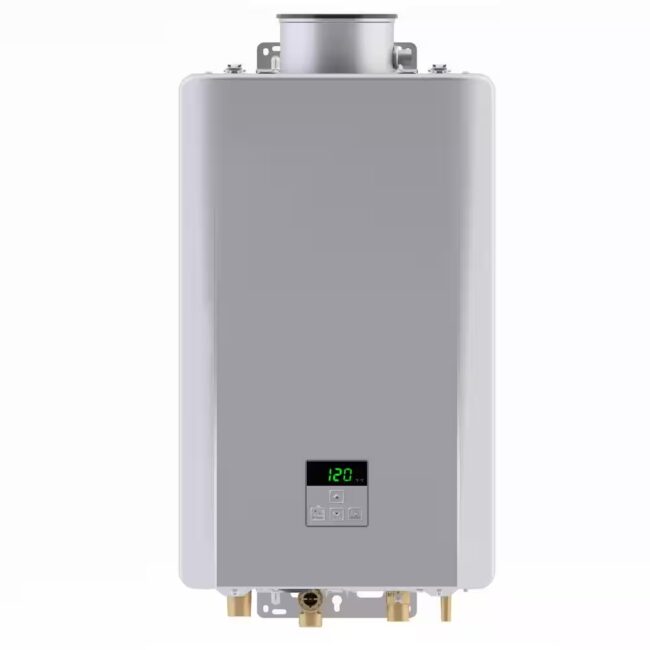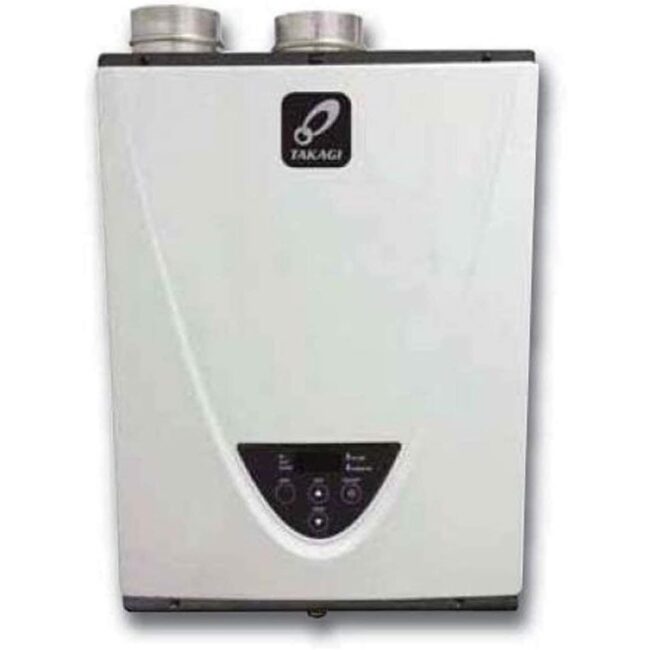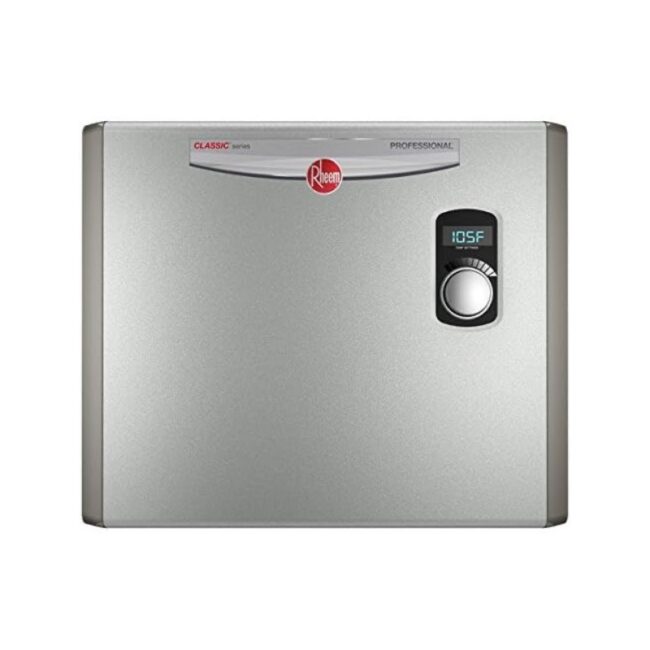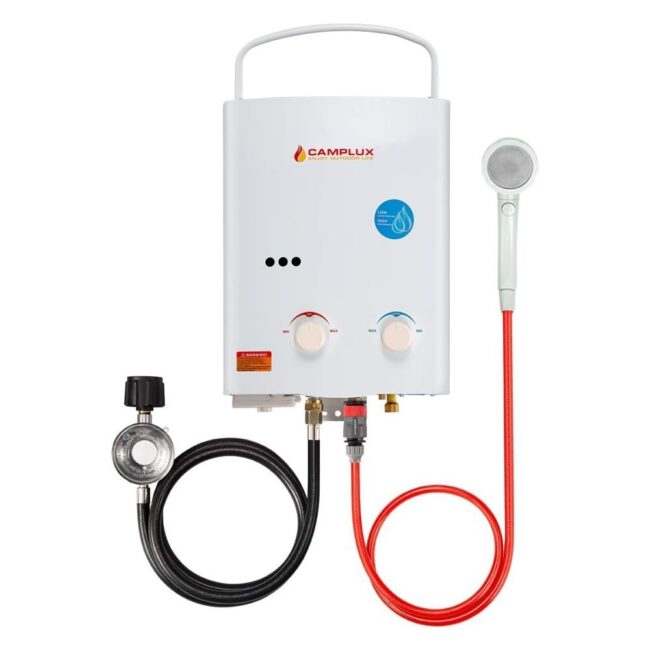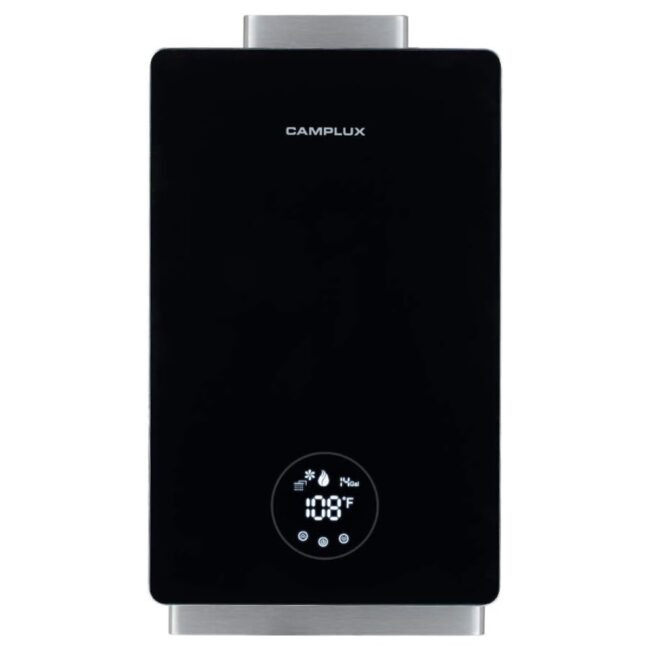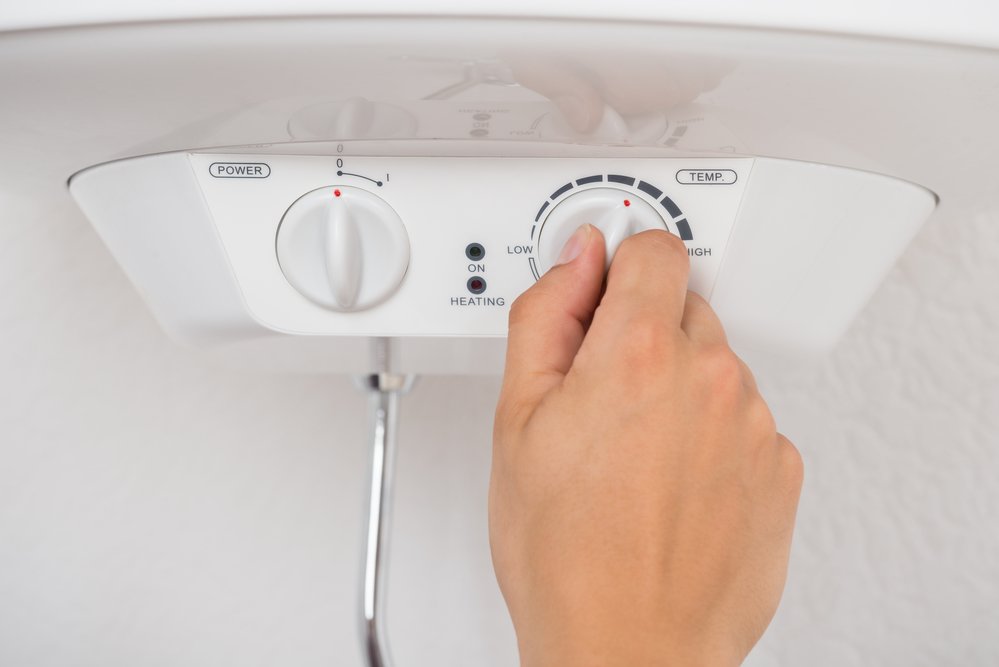
We may earn revenue from the products available on this page and participate in affiliate programs. Learn More ›
Tankless water heaters are more energy efficient than standard water heater storage tanks that heat up and store gallons of hot water. According to the U.S. Department of Energy, a tankless option can help increase energy efficiency by as much as 8 to 34 percent.
Tankless water heaters don’t need to store water, making them significantly smaller than a traditional storage tank. Instead, they heat water instantly as it enters the unit for a limitless supply of hot water.
As a project manager in the plumbing trades, I found that it was essential to use tankless water heaters that suited the property and the household. With this in mind, we looked at tankless water heater flow rates intended for a range of homes and living arrangements. Additionally, we researched the power output and fuel type to come up with this list of the best tankless water heaters. Read on to find out how the best tankless water heaters work and why the ones below made our list of top recommendations.
- BEST OVERALL: Rinnai RU180iN Tankless Water Heater
- BEST BANG FOR THE BUCK: Rheem RTEX-13 Tankless Electric Water Heater
- BEST ELECTRIC: Stiebel Eltron Tempra 36 Plus Tankless Water Heater
- BEST PORTABLE: Hike Crew Portable Propane Water Heater
- BEST POINT-OF-USE: EcoTouch Point-Of-Use Tankless Water Heater
- BEST WHOLE-HOUSE: Rinnai RE199iN High-Efficiency Tankless Water Heater
- BEST CONDENSING: Takagi High-Efficiency Gas Tankless Water Heater
- BEST NON-CONDENSING: Rheem RTEX-36 Self-Modulating Electric Water Heater
- BEST GAS: Rinnai RL75iN Tankless Hot Water Heater
- BEST FOR RV: Camplux Portable Propane Tankless Water Heater
- BEST SMALL: Camplux Constant Tankless Water Heater
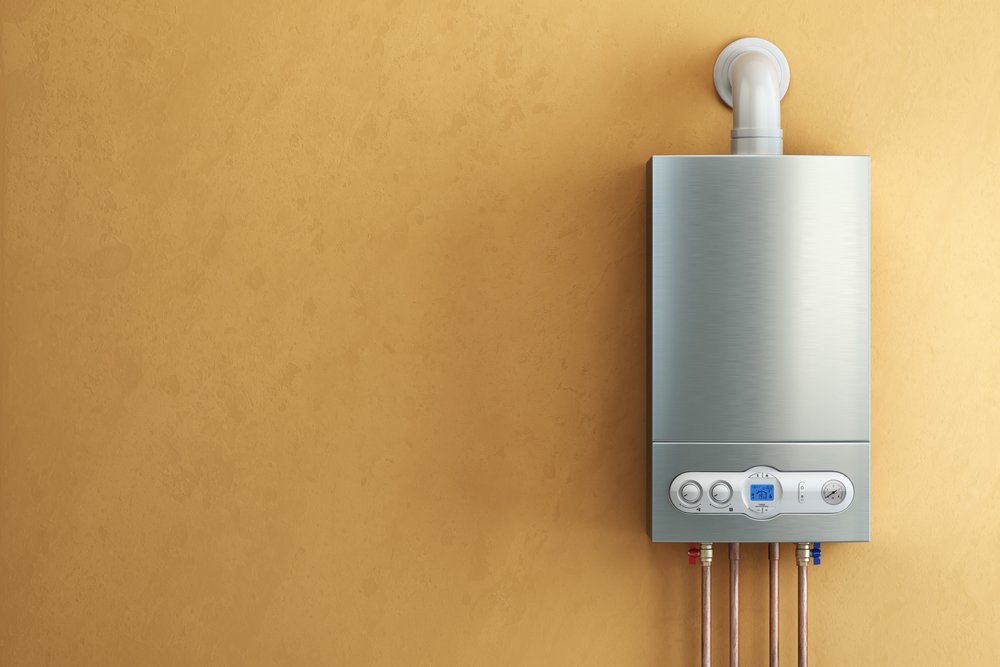
Before You Buy a Tankless Water Heater
Tankless water heaters are growing in popularity for the average homeowner; however, there are a few considerations to take into account before purchasing.
Tankless heaters will cost more initially, between $1,000 to $3,000 before installation. With installation costs included, the price rises to $2,000 to $6,000 nationwide on average, while storage-tank models only cost between $1,000 to $2,000 with installation.
Another thing to consider is the hot water requirements of the household. If multiple showers, a clothes washer, and a dishwasher are all expected to operate simultaneously, a tankless model may have trouble providing enough hot water to all locations at once. Bigger families with high demands may benefit from a large traditional model capable of keeping up with their needs, as a tankless unit requiring that type of power may be out of their price range.
Installation is another consideration. If your home has a storage-tank heater, expect that the electrical wiring, gas piping, water piping, and ventilation (for gas models) will likely need to be reconfigured to fit the much smaller wall-mounted tankless unit. The installation will typically take longer and cost more.
If these seem like reasonable expectations and limits based on your household and what you are looking for, read on to determine the best tankless water heater for you.
How We Chose the Best Tankless Water Heaters
We researched the most sought-after tankless water heaters in their respective categories and discovered that the best models are determined by their fuel type, flow rate, power input, energy efficiency, and other special features included by select brands.
While searching for the best models available, the most popular type among users were the electric tankless water heaters for their ample energy efficiency and ease of use. While not as popular, the natural gas and propane options are viable options for either whole-house use or portability on camping trips. No matter the type, the above options have ample flow rates of 1 to 11 gallons per minute (GPM) and power inputs ranging from 30,500 to 199,000 British thermal units (BTUs) based on how much hot water you need and the desired energy efficiency. (For a more in-depth discussion of GPM and BTUs, read the section What to Consider When Choosing a Tankless Water Heater that appears below our product reviews.)
With this in mind, the above options can provide water from one to two people to an entire household and brandish 81 to 99 percent energy-efficiency ratings, with select options coming with Energy Star certifications. As for added special features, some of these picks have easy-to-use dials or touch screens, self-modulation controls, safety shut-off features, Wi-Fi compatibility, and silent operation volumes.
Our Top Picks for the Best Tankless Water Heaters of 2023
Check out the best tankless water heaters on the market today, chosen for the quality of features described above as well as price, effectiveness, and manufacturer reputation.
Best Overall
Rinnai RU180iN Tankless Water Heater
Pros
- Produces water for up to 5 appliances; ideal for most home sizes
- Very energy-efficient water heater; Energy Star certified
- Wall-mounted option is compact and easy to install; will not take up too much space in a basement or utilities room
- Wi-Fi ready; can respond to voice commands for remote access
Cons
- Can take a few minutes to heat up on first use
Product Specs
- Fuel type: Natural gas
- Flow rate: 10 GPM
- Power input: 180,000 BTUs
The capabilities of the Rinnai RU180iN tankless water heater are impressive, with a 10 GPM max flow rate that can produce hot water for up to five appliances. The 180,000-BTU maximum is more than enough for a standard mixture of teens and adults in a single household to go through their morning routines without a drop in water temperature.
Despite it being a natural gas system, the unit’s efficiency rating sits comfortably between 93 and 96 percent and is Energy Star certified. This is mostly due to the condensing feature that allows the water heater to remove as much heat from the exhaust as possible before releasing it through the ventilation.
What our tester says: Debbie Wolfe, Bob Vila editor and product tester, says about this tankless water heater: “When it came time to replace my old tank water heater, my plumber highly recommended Rinnai due to its reputation for quality. He determined the 180,000 BTU 10 GPM model best fit my family’s hot water needs. The appliance heats the water quickly and is easily adjustable via the straightforward display on the front of the machine. I especially like that it doesn’t take up floor space in my basement—it fits neatly on the wall. There is a slight delay in hot water delivery first thing in the morning, when the tank has not been used for hours. However, once it’s activated, the hot water is readily available for the rest of the day.” Get the Rinnai RU180iN tankless water heater at Amazon, The Home Depot, or Build with Ferguson.
Best Bang for the Buck
Rheem RTEX-13 Tankless Electric Water Heater
Pros
- 99 percent efficiency rating; ideal choice for energy-conscious users
- Perfect for smaller homes; flow rate is suitable for homes with 1 to 2 people
- Easy-to-use dial; less complicated than other options
Cons
- Does not provide enough flow rate to service larger households
Product Specs
- Fuel type: Electric
- Flow rate: Up to 3.17 GPM, depending on inlet temperature
- Power input: Unspecified
This budget tankless electric water heater boasts an impressive 99 percent efficiency rating. This means the energy you are paying for is used almost entirely for your water, as opposed to losing energy through ventilation with gas models.
The Rheem RTEX-13 tankless water heater won’t be of much use to a large household with many different fixtures in use simultaneously. However, with a 3.17 GPM max flow rate, it is more than enough for an apartment or cottage with one or two occupants. The low price of the unit and the lower price of electric tankless water heaters in general when compared with gas make this a great value selection.
Get the Rheem RTEX-13 tankless water heater at Amazon, The Home Depot, or Grainger.
Best Electric
Stiebel Eltron Tempra 36 Plus Tankless Water Heater
Pros
- Silent operation volume; great for early morning showers or bungalows
- Stiebel’s Advanced Flow Control feature included to preheat water before use
- Easy-to-use digital display with a simple dial control allows for quick adjustments
Cons
- May not be compatible with some water fixtures
- Some users have reported malfunctions or poor water heating power
Product Specs
- Fuel type: Electric
- Flow rate: Up to 7.5 GPM, depending on inlet temperature
- Power input: Unspecified
The Stiebel Eltron Tempra 36 Plus tankless water heater is high efficiency at its best with a 99 percent efficiency rating, silent operation, and an impressive max flow rate of 7.5 gallons per minute in warmer climates. Like all electric tankless water heaters, this model offers immediate cost savings on the unit price and the installation costs.
Stiebel’s Advanced Flow Control feature keeps water consistently hot during ongoing use so that showers don’t cool down or fluctuate in temperature. A bold digital display shows accumulated cost savings so users can see how much they have saved by switching out an inefficient model.
Get the Stiebel tankless water heater at Amazon, Lowe’s, or The Home Depot.
Best Portable
Hike Crew Portable Propane Water Heater
Pros
- Comes with a built-in pump and carrying handle; heats at 18,771.5 BTUs
- Hand faucet and shower head attachment included for ease of use outdoors
- Fuse protection is a handy safety shut-off feature to prevent malfunction
Cons
- Suitable for small appliances and light-duty use only
Product Specs
- Fuel type: Propane
- Flow rate: Average of 0.58 GPM
- Power input: 18,771.5 BTUs
The Hike Crew portable propane water heater combines the luxuries of home with the ruggedness of camping. The built-in pump is placed into a water source and attached to a propane tank to provide ongoing hot water for camp showers, washing dishes, and rinsing equipment with an output of 18,771.5 BTUs.
A handle at the top of the water heater acts as a carrying-case system. The portable water heater comes with a hand faucet and shower head attachment to supply hot water anywhere, and it connects to AC/DC power. The little unit includes a safety shutoff to turn the burner off when it reaches 125 degrees Fahrenheit or when available water runs out. This portable unit only operates at less than 1 GPM on average, making it ideal as a mobile unit but not great for any other applications.
Get the Hike Crew tankless water heater at Amazon.
Best Point-of-Use
EcoTouch Point-Of-Use Tankless Water Heater
Pros
- Great as a supplemental unit for use in a single bathroom or kitchen
- Self-modulation controls provide consistent comfortable water temperature
- Touch screen is intuitive and easy to use; large digital display is suitable for those with limited vision
Cons
- Not suitable for use as a whole-house tankless water heater
Product Specs
- Fuel type: Electric
- Flow rate: Up to 1.8 GPM, depending on inlet temperature
- Power input: Unspecified
The low 1.8 GPM (maximum) would be detrimental for a household tankless water heater, but as a point-of-use unit, the heating power output is more than enough for a single bathroom or kitchen. The 99 percent efficiency rating of this unit means almost no heat is lost before the water reaches the shower, faucet, or any other single fixture.
The small size and sleek touch-screen design fit comfortably into the modern home style, making the appliance a part of the decor instead of merely taking up space. The self-modulation controls monitor the water temperature to avoid fluctuations between hot and cold while the fixture is in use. This model won’t be heating the entire home, but it could be a great hybrid choice for a primary bathroom.
Note that where you live and the average inlet water temperature of your area will affect the maximum flow rate of this water heater, which can fluctuate from 0.8 GPM in colder areas up to 1.8 GPM in warmer climates.
Get the EchoTouch tankless water heater at Amazon.
Best Whole-House
Rinnai RE199iN High-Efficiency Tankless Water Heater
Pros
- Can easily provide water to several fixtures at once; suitable for small- to medium-size houses
- Noncondensing model means a more affordable price point
- Helps save energy by only operating when hot water is needed
Cons
- Will require robust ventilation that can handle high temperatures
Product Specs
- Fuel type: Natural gas
- Flow rate: 9.8 GPM
- Power input: 199,000 BTUs
An endless supply of hot water for the whole house awaits with the Rinnai RE199iN natural-gas tankless water heater. Rinnai boasts that the 9.8-GPM flow rate and 199,000-BTU maximum provide hot water to up to six fixtures at once, allowing for a quick and argument-free morning when everyone needs to shower and get out the door.
The natural-gas tankless water heater is non-condensing, so its energy rating isn’t as high as the electric models or even the condensing gas types, with only a 0.82 uniform energy factor. However, because this tankless gas water heater is noncondensing, it is also more affordable, making it a good option for a big family in a long-term home.
While the savings may not pile up, they will still be noticeable.
Get the Rinnai RE199iN tankless water heater at The Home Depot.
Best Condensing
Takagi High-Efficiency Gas Tankless Water Heater
Pros
- Provides plenty of heating power for most household sizes; no more cold showers
- Compact unit that still packs impressive flow rate without taking up a lot of space in a basement or utility closet
- Control panel is simple and easy to understand for quick changes
Cons
- Can be noisy when running; may not be suitable for some users
Product Specs
- Fuel type: Natural gas
- Flow rate: 10 GPM
- Power input: 199,000 BTUs
With an impressive 10 GPM flow rate, the Takagi tankless water heater ensures an ample supply of hot water for an entire household’s needs. Say goodbye to inconvenient cold showers and hello to endless hot water on demand. Depending on the inlet temperature of the water in your area, this high-capacity unit can handle between three and four bathrooms at once.
Aside from its powerful output, the Takagi tankless water heater is engineered for energy efficiency. Its condensing technology recaptures and reuses exhaust heat, maximizing energy utilization and reducing utility bills. Experience the eco-friendly way to heat water without compromising on performance.
Get the Takagi tankless water heater at Amazon or Build with Ferguson.
Best Non-Condensing
Rheem RTEX-36 Self-Modulating Electric Water Heater
Pros
- Super compact design; great for homes where space is limited
- Excellent energy efficiency and self-modulation technology keep hot water on hand for instant access
- Digital temperature display is straightforward to control with 1 turn dial
Cons
- Flow rates will vary depending on the inlet water temperature of your area
Product Specs
- Fuel type: Electric
- Flow rate: Up to 8.8 GPM
- Power input: Unspecified
The Rheem RTEX-36 electric tankless water heater is a highly efficient and compact unit designed to meet your hot water needs. It operates as a noncondensing water heater with an impressive 99.8 percent energy efficiency rating, which helps reduce energy consumption and lower utility costs.
Measuring just 18.25 inches high by 21.63 inches wide, its compact design makes it an ideal choice for homes with limited space, such as apartments, condos, or smaller houses. Despite its size, it can deliver a maximum flow rate of up to 8.8 gallons per minute, ensuring a continuous supply of hot water for users’ needs.
The digital temperature control, operated by a dial, allows for easy and precise adjustments, ensuring your hot water is set at the desired temperature for your comfort.
Moreover, the Rheem RTEX-36 features self-modulation technology that automatically adjusts the heating power to match the hot water demand, resulting in efficient energy usage without unnecessary wastage.
Get the Rheem RTEX-36 tankless water heater at Amazon, The Home Depot, or Build with Ferguson.
Best Gas
Rinnai RL75iN Tankless Hot Water Heater
Pros
- High-tech construction; includes Wi-Fi capability for remote control and monitoring
- Recirculation technology can help reduce wait time for hot water
- Also includes a pressure relief valve and isolation valves
Cons
- Descaling maintenance is recommended for better lifespan
Product Specs
- Fuel type: Natural gas
- Flow rate: 7.5 GPM
- Power input: 180,000 BTUs
The Rinnai RL75iN tankless water heater is a powerful and advanced unit that guarantees a steady and efficient hot water supply. With a maximum of 180,000 BTUs, this model delivers exceptional performance, ensuring a consistent flow of hot water for your household needs.
Its maximum flow rate of 7.5 GPM ensures a luxurious and uninterrupted hot water experience. The RL75iN is equipped with Wi-Fi capability, offering convenient remote control and monitoring through a compatible device. Moreover, this water heater can be easily paired with an external pump for on-demand recirculation, significantly reducing wait times for hot water and ensuring comfort and convenience whenever needed.
Get the Rinnai RL75iN tankless water heater at Amazon, The Home Depot, or Build with Ferguson.
Best For RV
Camplux Portable Propane Tankless Water Heater
Pros
- Lightweight and easily portable; great for luxury RV trips
- 2 dials can control temperature and water flow; simple to use compared to some other options
- Easy installation; can even hook up directly to a hose spigot
- Has a shower head attached directly to the unit for convenience
Cons
- Less durable and prone to breakages if handled poorly
Product Specs
- Fuel type: Propane
- Flow rate: 1.32 GPM
- Power input: 34,000 BTUs
The Camplux portable propane tankless water heater is an ideal solution for RV adventures, offering convenience and efficiency on the go. Designed with portability in mind, this lightweight 10-pound unit ensures you can have hot water wherever your journey takes you.
With its two easy-to-use control dials, adjusting the temperature and water flow is a breeze. Simply customize your hot water experience according to your preferences, providing comfort during your outdoor activities.
The Camplux propane water heater can be easily attached directly to a hose spigot, making setup quick and hassle-free. No need to worry about bulky installations or complicated plumbing.
Operating at a flow rate of 1.32 GPM and 34,000 BTUs per hour, this tankless water heater efficiently delivers hot water for various activities, ensuring a cozy and enjoyable experience during your RV road trips.
Get the Camplux portable tankless water heater at Amazon, Lowe’s, The Home Depot, or Walmart.
Best Small
Camplux Constant Tankless Water Heater
Pros
- Compact design fits well in tighter spaces; great for apartments or condos
- Includes various safety features; prevents overheating and freezing
- Sleek, modern design doesn’t look ugly if installed in plain sight
Cons
- Limited flow rate compared to larger units
Product Specs
- Fuel type: Natural gas
- Flow rate: 3.18 GPM
- Power input: 82,000 BTUs
Measuring just 25.39 inches tall by 14.37 inches wide, the Camplux constant water heater is a compact and efficient appliance designed for practical use. With a modern black design, it features a digital display and user-friendly control panel for easy operation.
Capable of delivering a steady flow of 3.18 GPM and a maximum input rating of 82,000 BTUs, this water heater ensures a reliable supply of hot water. Safety is a priority, as it comes equipped with antifreeze and overheating protection.
The unit offers automatic temperature controls, enabling convenient customization of water temperature, and includes an energy-saving mode for efficiency. Additionally, a child-lock feature provides safety around curious little ones.
Get the Camplux constant tankless water heater at Amazon, Lowe’s, The Home Depot, or Wayfair.
Jump to Our Top Picks
What to Consider When Choosing a Tankless Water Heater
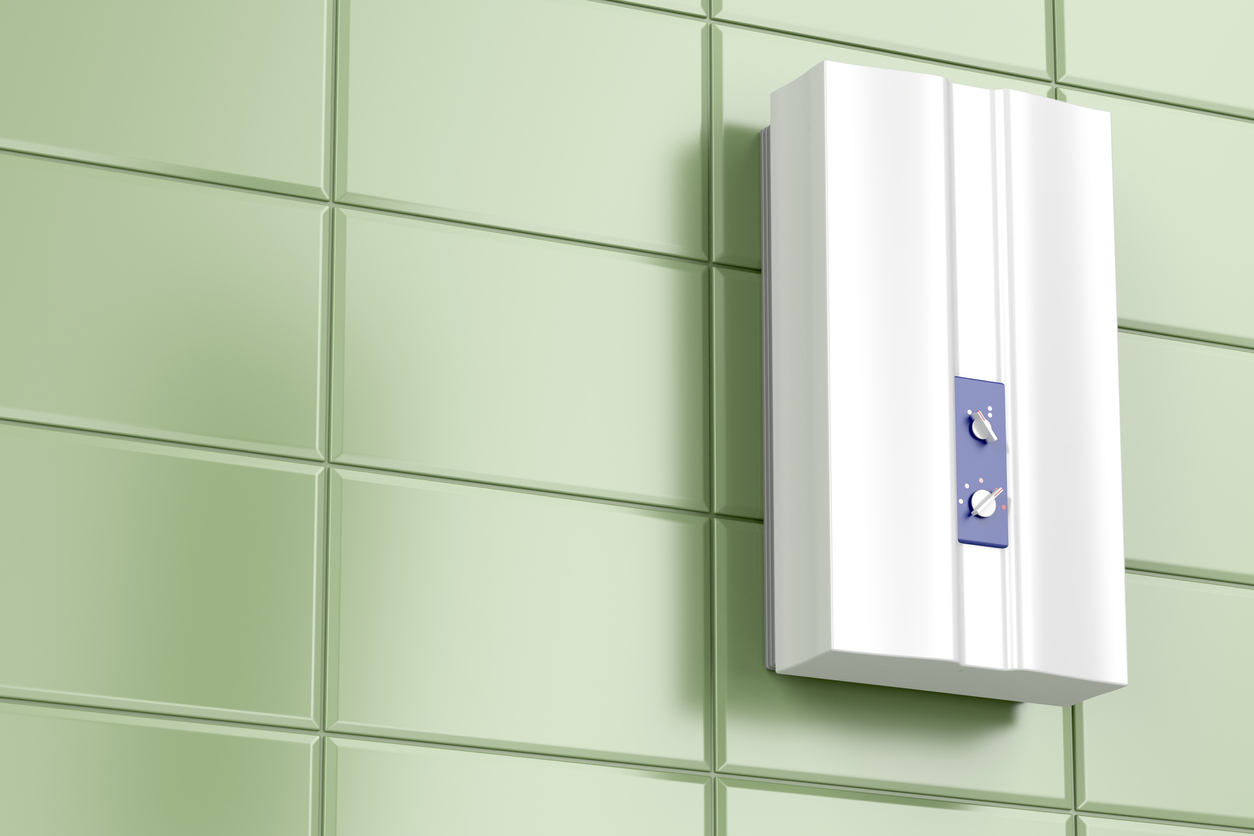
Immediate access to hot water and reduced energy consumption throughout the year are just two of the benefits of a tankless water heater. To choose a tankless water heater based on features that will be most beneficial to your home, keep in mind the type, flow rate, power consumption, and more.
Fuel Type
There are three main types of fuel for a tankless water heater: natural gas, propane, and electricity. Gas models operate at a higher power output than electrical models, allowing both propane and natural gas to heat more water to an ideal temperature for a lower cost.
The downside to this is that the initial cost of a gas tankless water heater is about $1,000 more than an electric heater. The installation is more complex, provided that the home has an electrical system able to support the high energy needs of an electric heater.
- Natural gas costs less than propane and electricity and has the added convenience of direct piping into many homes. This style is best for a long-term investment, as the lower cost of the natural gas will eventually cover the money spent on the unit. Natural gas is also a good choice for high-demand households. However, natural gas is not easily stored, and these models are poor for mobile use in an RV or at a campsite. Also, keep in mind that your home may not have natural gas piped in. If this is the case, running a line into your home will add more cost to the installation.
- Propane gas is the most expensive of the fuel choices, which often cannot be piped into a home. It is more likely you will need to purchase a fuel tank for the water heater, taking up space saved by the move to tankless style. These water heaters provide the best energy output, with propane even providing more energy than natural gas. Propane tankless water heaters are great for use in a recreational vehicle due to the portability of liquid propane.
- Electric tankless water heaters are the cheapest choice for initial purchase and installation, but high electrical needs and lower overall power output can even the cost in a hurry. One important thing to note about electrical models is that their efficiency rating is about 10 percent higher than gas models. Therefore, an electrical model can save more energy overall than a gas model. However, it may cost more, depending on the current price of electricity versus gas in your local area. Electrical models also have high power requirements that an older home might not meet. If the current electrical system does not meet the manufacturer’s specifications, a different style may be needed, or a costly upgrade to the electrical system will be necessary.
Flow Rate (GPM)
The tankless water heater’s flow rate determines the maximum flow of hot water that the tank is capable of producing. Flow rate is measured in GPM with each fixture (tub, shower, sink, etc.) requiring a certain portion of this flow. For example, a tub will use 4 GPM, a shower will use 3 GPM, and a kitchen sink will use 1.5 GPM on average. If they are all in use at once, the tankless water heater will be required to provide 8.5 gallons of hot water per minute.
Those who live in homes with more than four adults will want to consider tankless water heaters with a flow rate of 7.5 to 8 GPM, while homes with less than four adults should be fine with a flow rate of 3 to 5 GPM.
When determining the flow rate, consider the amount of water used all at once in the household. If only one shower, sink faucet, clothes washer, etc., is ever in use at one time, a lower flow rate is adequate. However, if multiple showers, a dishwasher, a clothes washer, and a couple of sinks run simultaneously, a lower flow rate cannot provide hot water to all appliances at once.
Whole-house tankless water heaters are larger and more powerful than point-of-use tankless water heaters. These models provide sufficient hot water to an entire house and have much higher flow rates and power inputs. Point-of-use designs are intended to be used on a single fixture, so they only require enough flow and power input to heat one shower or one sink.
These are great if you can afford multiple tankless water heaters or plan to use them in conjunction with a traditional tank model, where the point-of-use water heater is only used for a primary shower that would otherwise drain the tank.
Power Input (BTU)
The energy required to heat water to your desired temperature is called the power input, which is measured in BTUs. A BTU refers to the amount of energy needed to raise the temperature of one pound of water by one degree Fahrenheit.
To decide on the necessary power input for your tankless water heater, consider a simple situation. Assuming the water coming into your home is 40 degrees Fahrenheit, and you would like your shower to produce water at a temperature of 120 degrees Fahrenheit; then the tankless water heater would need to increase the temperature by 80 degrees Fahrenheit. To do so, it would need 667 BTUs per gallon (assuming a flow rate of almost zero).
A shower operates at 2.5 GPM or 150 gallons of water per hour. To heat 150 gallons of 40-degree Fahrenheit water per hour to a temperature of 120 degrees Fahrenheit, a tankless water heater would need to produce 100,000 BTUs per hour, assuming a 100 percent efficiency for a single shower. If the efficiency levels drop or another fixture is used at the same time, the BTU requirements go up.
The basic formula is:
(500 x GPM x Temperature Change = Required Power Input in BTU per Hour)
Efficiency Percentage
Note that 500 (or 499.8 rounded up) is the weight of a gallon of water (8.33 lbs) multiplied by 60 minutes.
Use this as a starting point to determine the BTUs required for your home and geographic location to heat incoming water to the desired temperature.
Venting
Gas tankless water heaters burn their fuel and transfer the energy from the burning fuel into the water to raise its temperature. However, when fuel burns, it produces exhaust that must be vented outside of the home, keeping a safe distance from doors, windows, air conditioning units, and any other areas that see regular use by people or pets.
This ventilation piping will need to be installed with the tankless water heater and could drastically increase the cost depending on the heater’s location and the requirements to run the ventilation from the heater to a safe location outside. Depending on the layout of the home, this could mean direct ventilation through the basement wall or chimney ventilation that runs vertically through your house and emerges from the roof.
Condensing vs. Noncondensing
Steam or water vapor is a byproduct of the fuel burning in a tankless water heater. The steam releases through ventilation ducts or piping to the outside. The difference between condensing and noncondensing is when the steam is released.
- Noncondensing tankless water heaters will immediately vent the steam, meaning that ventilation materials will need to be able to withstand high temperatures as hot steam travels through the ventilation channels. These premium materials come at a cost, so installation prices can be higher. The heat lost through the immediate ventilation of this steam also results in an efficiency rating of about 80 to 85 percent. However, noncondensing water heaters will be cheaper to purchase.
- Condensing tankless water heaters have a condensing unit that captures and reuses the residual exhaust heat before releasing a much cooler exhaust through ventilation channels to the outside. This style costs more money but saves on ventilation material and produces about 98 percent efficiency.
The Advantages of Owning a Tankless Water Heater
The advantages of a tankless model are numerous, which is why they often have a higher initial price tag. However, that upfront cost can come back to you in the form of government rebates and savings of between 24 and 34 percent over the storage-tank water heater, according to the U.S. Department of Energy.
The innovative tankless heaters also take up significantly less space than a traditional water heater because they don’t need to store gallons of water in advance to provide adequate hot water to your home. The nearly instant heating process lets you enjoy all of the amenities your home has to offer without running out in the shower or wash cycle.
- Tankless water heaters take up less space than storage-tank water heaters.
- The tankless economic models reduce wasted energy and save money on bills.
- Tankless heaters provide instant access to hot water without worrying about running out when you need to hop in the shower.
FAQs
Don’t buy before reviewing the answers to a few common tankless water heater questions below.
Q. How does a tankless water heater work?
Tankless water heaters work by using a heating element (heat exchanger) to heat the cold water that enters the unit. A flow-activated switch turns the heating element on as water is drawn through the unit by the opening of a faucet in the home. The water flows through a series of loops within the unit, ensuring that it has enough time to reach optimal temperatures before exiting at the required hot water source.
Q. What size tankless water heater do I need?
The size of the tankless water heater required depends on the number of occupants in the home, the usage requirements, the size of the house, and the average temperatures of the geographic area, as lower average temperatures will require an increased output to heat water to the optimal temperature. Homes with one to three occupants require 3- to 5-GPM water heaters. Homes with four or more people may require units that are capable of managing up to 8 or 9 GPM.
Q. How do you flush a tankless water heater?
The general procedure requires you to shut off the flow of electricity, water, and gas (if it is a gas unit) to the tankless water heater. Once done, connect two hoses to the cold- and hot-water isolation valves. The hose connected to the hot water should not be connected to anything else, while the hose connected to the cold water should be attached to a pump.
Submerge the pump in a 5-gallon bucket filled with about 4 gallons of clean white vinegar and place the open end of the hot water hose in the bucket as well. Open the isolation valves and turn the pump on, allowing it to circulate vinegar through the tankless water heater for 45 minutes to an hour. After this, turn off the pump and empty the bucket. Turn on the cold water to the unit, allowing the water to flow through and flush out the vinegar for 5 minutes.
Once completed, turn off the valves; disconnect the hoses; and return the tankless water heater to functionality by restoring water, gas (if it is a gas heater), and electricity to the unit. Test to ensure it is working correctly. If not, check your connection and ensure all power and fuel sources are properly restored. If a problem is present, consider contacting a local plumber for help.
Q. How do you install a tankless water heater?
Installing a tankless water heater is a complex process that requires highly technical skills such as soldering pipes, making gas connections, and following local codes. Safety and proper installation are crucial when dealing with tankless water heaters, and a qualified technician will ensure the replacement is done correctly and in compliance with local regulations. It is recommended to hire a licensed professional for the job.
Q. How much should a tankless water heater cost?
The cost of a tankless water heater can vary depending on several factors, including the brand, model, capacity, features, and the region where you live. On average, a tankless water heater can cost anywhere from $150 for more compact and portable models to $2,000 or more for larger and more powerful units.
Q. Can tankless water heaters run out of hot water?
Since tankless water heaters do not have a storage tank like traditional water heaters, they do not run out of hot water because they heat the water on demand, providing a continuous supply as long as the demand doesn’t exceed their maximum flow rate and capacity.

